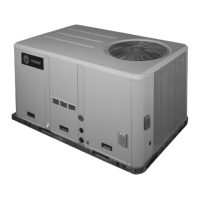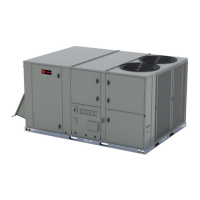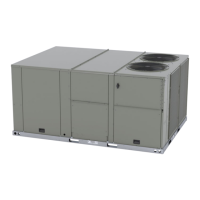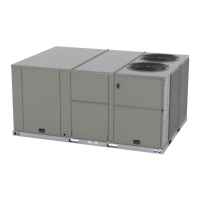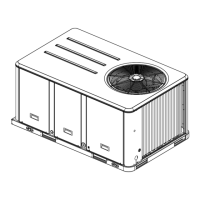58
RT-SVX075C-EN
terminal connections, as well as damaged wire
insulation. Make any necessary repairs.
• Verify the electric heat system operates properly.
Coil Cleaning
Regular coil maintenance, including annual cleaning,
enhances the unit’s operating efficiency by minimizing the
following:
• Compressor head pressure and amperage draw
• Evaporator water carryover
• Fan brake horsepower
• Due to increase static pressure losses
• Airflow reduction
WARNING
Hazardous Chemicals!
Failure to follow this safety precaution could result in
death or serious injury. Coil cleaning agents can be
either acidic or highly alkaline and can burn severely
if contact with skin or eyes occurs.
Handle chemical carefully and avoid contact with
skin. ALWAYS wear Personal Protective Equipment
(PPE) including goggles or face shield, chemical
resistant gloves, boots, apron or suit as required. For
personal safety refer to the cleaning agent
manufacturer’s Materials Safety Data Sheet and follow
all recommended safe handling practices.
At least once each year, or more often if the unit is located
in a dirty environment, clean the condenser coils using the
instructions below. Follow these instructions as closely as
possible to avoid damaging the coils.
Note: For units equipped with hail guards follow removal
procedure listed below.
Hail Guard Removal
1. Remove shipping screws (ones without washers).
2. Lift hail guards up so screws with washers go to top of
keyhole.
3. Remove hailguard by sliding washer head screw
through keyhole.
• To clean refrigerant coils, use a soft brush and a
sprayer (either a garden pump-up type or a high-
pressure sprayer).
• A high-quality detergent is also required; suggested
brands include “SPREX A.C.”, “OAKITE 161”, “OAKITE
166” and “COILOX”.
• If the detergent selected is strongly alkaline (ph value
exceeds 8.5), add an inhibitor.
Microchannel (MCHE) Coils
NOTICE
Coil Damage!
Failure to follow instructions below could result in
coil damage.
DO NOT use any detergents with microchannel
condenser coils.
Use pressurized water or air ONLY, with pressure no
greater than 600psi.
For additional information regarding the proper
microchannel coil cleaning procedure, refer to RT-
SVB83*-EN
• Due to the soft material and thin walls of the MCHE
coils, the traditional field maintenance method
recommended for Round Tube Plate Fin (RTPF) coils
does not apply to microchannel coils.
• Chemical cleaners are a risk factor to MCHE due to the
material of the coil.
• The manufacturer does not recommend the use of
chemical cleaners to clean microchannel coils. Using
chemical cleaners could lead to warranty claims being
further evaluated for validity and failure analysis.
The recommended cleaning method for microchannel
condenser coils is pressurized water or air with a non-
pinpoint nozzle and an ECU of at least 180 with pressure
no greater than 600 psi. To minimize the risk of coil
damage, approach the cleaning of the coil with the
pressure washer aimed perpendicular to the face of the coil
during cleaning.
Note: For more details on microchannel coil cleaning,
please refer to bulletin RT-SVB83*-EN.
Hail Guard Reinstallation
Reinstall hail guards by aligning the keyholes over the
washer screw heads, and slide into place. If the installation
requires seismic or special wind load compliance, reinstall
shipping screws.
Hot Gas Reheat Additional Oil
NOTICE
Compressor Damage!
Use of incorrect refrigerant and oil could result in
compressor damage and improper unit operation.
Use only refrigerant and oil specified on the unit
nameplate.
Additional refrigerant oil has been added in the factory for
all hot gas reheat units. If major components (MCHE coil,
valve assembly, etc.) are replaced or serviced, the
following steps must be taken.
1. Measure the amount of oil removed during servicing.
2. When recharging the unit after servicing, replace the
amount of oil removed, as measured in step 1. Verify oil
added is the correct type.
Maintenance
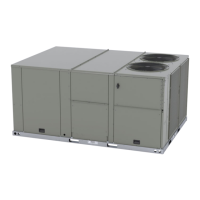
